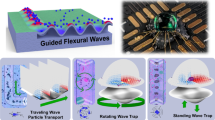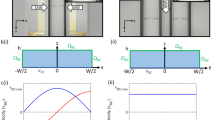Abstract
Pumping and manipulation of liquids in microfluidic channels are important for many mechanical, chemical and biomedical applications. Surface acoustic wave based devices fabricated on high-efficiency piezoelectric substrates have been recently investigated for mixing and separation application within microfluidic channels. In this paper, we introduce a novel integrated surface acoustic wave based pump for liquid delivery and precise manipulation within a microchannel. The device employs a hydrophobic surface coating (Cytop) in the device design to decrease the friction force and increase the bonding. Contrary to previous surface acoustic wave based pumps which were mostly based on the filling and sucking process, we demonstrate long distance media delivery (up to 8 mm) and high pumping velocity increasing the device’s application space and mass production potential. Additionally, the device design does not need precise layers of water and glass between substrate and channel, simplifying the design significantly. In this study, we conducted extensive parametric studies to quantify the effects of the liquid volume pumped, microchannel size, input applied power as well as the existence of hydrophobic surface coating on the pumping velocity and pump performance. Our results indicate that the pumping velocity for a constant liquid volume with the same applied input power can be increased by over 130 % (2.31 vs 0.99 mm/min) by employing a hydrophobic surface coating (Cytop) in a thinner microchannel (250 vs 500 µm) design. This device can be used in circulation, dosing, metering and drug delivery applications which necessitates small-scale precise liquid control and delivery.












Similar content being viewed by others
References
Alghane M et al (2011) Streaming phenomenon induced by Rayleigh surface acoustic wave in microdroplets. J Appl Phys 109:0–12
Alghane M et al (2012) Frequency effect on streaming phenomenon induced by Rayleigh surface acoustic wave in microdroplets. J Appl Phys 112:084902
Cecchini M, Girardo S, Pisignano D, Cingolani R, Beltram F (2008) Acoustic-counterflow microfluidics by surface acoustic waves. Appl Phys Lett 92:104103
Cordeiro AL et al (2009) Fluorination of poly(dimethylsiloxane) surfaces by low pressure CF 4 plasma—physicochemical and antifouling properties. Express Polym Lett 3:70–83
Dung Luong T, Trung Nguyen N (2010) Surface acoustic wave driven microfluidics—a review. Micro Nanosyst 2:217–225
Feder ME Environmental Physiology of the Amphibians. (University of Chicago Press, 1992). https://books.google.com/books?hl=en&lr=&id=oaS-OpEjPtUC&pgis=1. Accessed 1 Nov 2015
Girardo S, Cecchini M, Beltram F, Cingolani R, Pisignano D (2008) Polydimethylsiloxane–LiNbO3 surface acoustic wave micropump devices for fluid control into microchannels. Lab Chip 8:1557
Guldiken R, Jo MC, Gallant ND, Demirci U, Zhe J (2012a) Sheathless size-based acoustic particle separation. Sensors 12:905–922
Guldiken R, Jo MC, Gallant ND, Demirci U, Zhe J (2012b) Sheathless size-based acoustic particle separation. Sensors (Basel) 12:905–922
Jo MC, Guldiken R (2012) Active density-based separation using standing surface acoustic waves. Sens Actuators A Phys 187:22–28
Jo MC, Guldiken R (2013) Dual surface acoustic wave-based active mixing in a microfluidic channel. Sens Actuators A Phys 196:1–7
Jo MC, Guldiken R (2014a) Particle manipulation by phase-shifting of surface acoustic waves. Sens Actuators A Phys 207:39–42
Jo MC, Guldiken R (2014b) Effects of polydimethylsiloxane (PDMS) microchannels on surface acoustic wave-based microfluidic devices. Microelectron Eng 113:98–104
Kaletta UC, Wenger C (2014) FEM simulation of Rayleigh waves for CMOS compatible SAW devices based on AlN/SiO2/Si(100). Ultrasonics 54:291–295
Kockmann N (2006) Micro process engineering. Fluid Dyn Comput Model Appl. doi:10.1002/9783527616749
Laser DJ, Santiago JG (2004) A review of micropumps. J Micromechanics Microengineering 14:R35–R64
Masini L et al (2010) Surface-acoustic-wave counterflow micropumps for on-chip liquid motion control in two-dimensional microchannel arrays. Lab Chip 10:1997
Mata A, Fleischman AJ, Roy S (2005) Characterization of polydimethylsiloxane (PDMS) properties for biomedical micro/nanosystems. Biomed Microdevices 7:281–293
Mohanan A, Islam M, Ali S, Parthiban R, Ramakrishnan N (2013) Investigation into mass loading sensitivity of sezawa wave mode-based surface acoustic wave sensors. Sensors 13:2164–2175
Murochi N, Sugimoto M, Matsui Y, Kondoh J (2007) Deposition of thin film using a surface acoustic wave device. Jpn J Appl Phys 46:4754–4759
Rahimi P, Ward C (2005) Kinetics of evaporation: Statistical rate theory approach. Int J Thermodyn 8:1–14
Schmid L, Wixforth A, Weitz DA, Franke T (2012) Novel surface acoustic wave (SAW)-driven closed PDMS flow chamber Microfluid. Nanofluidics 12:229–235
Shabani R, Cho HJ (2011) Active surface tension driven micropump using droplet/meniscus pressure gradient. 2011 16th International Solid-State Sensors, Actuators Microsystems Conference TRANSDUCERS’11 180:1296–1299
Sritharan K, Strobl CJ, Schneider MF, Wixforth A, Guttenberg Z (2006) Acoustic mixing at low Reynold’s numbers. Appl Phys Lett 88:054102
Tan MK, Yeo LY, Friend JR (2009) Rapid fluid flow and mixing induced in microchannels using surface acoustic waves. EPL Europhys Lett 87:47003
Tseng W-K, Lin J-L, Sung W-C, Chen S-H, Lee G-B (2006) Active micro-mixers using surface acoustic waves on Y-cut 128° LiNbO3. J Micromechanics Microengineering 16:539–548
Uchida D et al. (2003) PDMS Microfluidic devices with PTFE passivated channels. 7th International Conference Miniaturized. Chem Biochem Anal Syst 429–432
Author information
Authors and Affiliations
Corresponding author
Rights and permissions
About this article
Cite this article
Wang, T., Ni, Q., Crane, N. et al. Surface acoustic wave based pumping in a microchannel. Microsyst Technol 23, 1335–1342 (2017). https://doi.org/10.1007/s00542-016-2880-9
Received:
Accepted:
Published:
Issue Date:
DOI: https://doi.org/10.1007/s00542-016-2880-9




